While there has been much focus on the Bell Laboratories facility in Holmdel, NJ as the site of Karl Jansky’s discovery of radio waves from the center of our Milky Way galaxy, a discovery which led scientists to the study called radio astronomy, there is little mention of Jansky’s early efforts at a small experimental station set up by Western Electric at Cliffwood, New Jersey. Jansky built his famous short-wave antenna at the Cliffwood Experimental Station, where he worked from 1928 to 1930. Jansky was dismayed when the rig had to be disassembled, moved and rebuilt in Holmdel in the early 1930s. But space was inadequate in Cliffwood to conduct the next phase of experiments.
After considerable research, the Matawan Historical Society has narrowed down the location of the Cliffwood experimental station to an area near the present-day intersection of County Road and State Route 35 in the Cliffwood section of Aberdeen Township, New Jersey. News reports indicate that Western Electric purchased forty acres of land in 1919 and hired a local contractor to erect a shack and pole antennae. Permanent facilities would follow, along with a team of engineers and scientists.
Awareness of the Cliffwood station and its role in radio astronomy’s birth faded over time. The building remained vacant through the 1930s and was destroyed in a fire in the summer of 1940.
This is not the complete story of the Cliffwood Experimental Station, but the following details paint an adequate picture until more work is done.
WESTERN ELECTRIC ACQUIRES LAND IN CLIFFWOOD
“About thirty years ago, the time seemed ripe for the Bell System to begin development looking toward extension of telephone service to ships at sea. During World War I, which had just ended, the Laboratories – then the Engineering Department of the Western Electric Company – had developed successful two-way radio systems for sub-chasers and for airplanes. On this foundation the new system was to be built by a team under the late H W Nichols.
“From New York’s Lower Bay and the North Jersey Coast, the rolling country of Monmouth County sweeps inland. Here was to be found an appropriate site for the radio station. In the summer of 1919, representatives of Western and of the Department of Development and Research of AT&T surveyed the area between Perth Amboy, Long Branch and Lakewood. They recommended a location near Cliffwood, which was bought. So was established a foothold in Monmouth County from which were to proceed great advances in radio.” (Source: The Laboratories in Monmouth County, Bell Laboratories Record, Vol XXVIII, March 1950, pg 97)
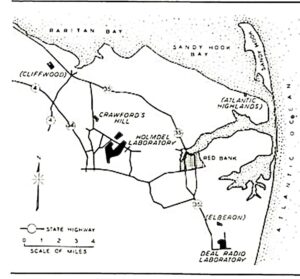
Above: Map showing Bell Laboratories research facilities in northeastern Monmouth County in the early to mid-20th century
Bell Telephone Laboratories described its experimental station in Cliffwood as being one of three fixed site stations conducting radio activities in New Jersey. The Cliffwood operation, a receiving station, was on a 40-acre company-owned plot of land near Matawan. (Source: Our Far-Flung Outposts, Bell Laboratories Record, Volumes I and II, September 1925 to September 1926, published by Bell Telephone Laboratories)
Bell Laboratories has a 40-acre station at Cliffwood, where short-wave radio studies are conducted. (Source: Monmouth Democrat, 7 Aug 1930; Item of Millburn and Short Hills, 7 Aug 1930)
The Atlantic Highlands Journal incorrectly placed the site in Middlesex County:
Western Electric has a station at Cliffwood, in Middlesex County, just beyond Keyport. (Source: Atlantic Highlands Journal, 18 Dec 1919)
SETTING UP THE CLIFFWOOD STATION
“The Western Electric Telegraph Company is erecting a number of wireless stations in New Jersey, one of which is being built on the Gehlhaus Brickyard property at Cliffwood. The building is twenty feet square and a dynamo and other instruments needed in the operation of the station will be placed in it. The poles will extend up about eighty feet from the ground and Samuel Stryker is in charge of the construction work. A lease of the property has been taken for two years. The company has other stations at Little Silver and Belmar, in this county, and at Cape Cod and other places.” (Sources: Keyport Weekly, 22 Aug 1919; Daily Register, Aug 22, 1919)
“Work was begun promptly at Cliffwood by putting up a temporary building and starting work on the scale model of an antenna.” (Source: The Laboratories in Monmouth County, Bell Laboratories Record, Vol XXVIII, March 1950, pg 97)
GEHLHAUS BRICK COMPANY
The Charles Gehlhaus Company was incorporated in 1906 as a brick, clay and cement company. Otto F Gehlhaus was the registered agent based at Cliffwood. (Source: Matawan Journal, 28 Jun 1906.)
“The Gehlhaus Brickyard consisted of what today are the Addison Park banquet hall, the Commerce Plaza strip mall, and the iStorage facility at the intersection of County Road and State Route 35.” (Source: Edward Fitzgerald, Feb 2024)
HENDRICK VAN CLEAF FARM
Morrisey and Walker Company approached Matawan Township seeking permission “to extend its water mains to the Brown and Langan property and also to the H Van Clief farm where the experimental plant of the Western Electric Company is located.” (Source: Matawan Journal, 2 Sep 1927)
The Van Cleaf farm was once owned by Hendrick Van Cleaf and included much of the land on both sides of County Road between the Gehlhaus property and the Rose farm (roughly to the railroad tracks, Kennedy Avenue). The Cliffwood Beach Company planned to sub-divide its holdings in that area, laying out several streets named after New Jersey counties, including Mercer, Somerset, Union, Warren and Salem. Only Salem Place was developed. The H Van Cleaf farm mentioned in the 1927 article above is on the Salem Place site, also referred to as the Little Farm. (Source: Edward Fitzgerald, Feb 2024)
“Van Cleaf Lane – Named for a longtime local family. Hendrick Van Cleaf of Kings County, New York, bought 200 acres between Whale Creek and Long Neck Creek from Jonathan Forman on April 4, 1794. Forman had purchased the land from Maj. John Burrowes in 1787. Portions of the property would remain in the Van Cleaf family well into the 20th century.” (Source: Aberdeen Street Names, by Edward Fitzgerald)
“Van Cleaf Lane was an access road from Cliffwood Avenue to their farm. First mentioned as ‘road of two rods in width’ April 23, 1858, in deed from David Hunter McAlpin to John B Stratton (Y6 Deeds 485) Portion vacated May 15, 1978. Ordinance No 3-1978.” (Source: Aberdeen Street Names, by Edward Fitzgerald)
Salem Place intersects at the west side of County Road. It is an apparent extension of Van Cleaf Lane, which once extended east from County Road to Long Neck Creek. Van Cleaf Lane exists today, intersecting the west side of Cliffwood Avenue toward Long Neck Creek in line with Salem Place. (Source: Pat Noble, Feb 2024)

Above: A satellite map shows the approximate location of the Van Cleaf property in Cliffwood. In the upper left is County Road at Salem Place. Long Neck Creek parallels County Road to the east, from the bottom left to center right. Van Cleaf Lane (unlabeled) can be seen bottom center, just to the south of Cliffwood Elementary School on Cliffwood Avenue.
BELL LABORATORIES CREATED 1 JANUARY 1925
Bell Telephone Laboratories took over operation of the Research and Development Laboratories of the American Telephone and Telegraph Company and the Western Electric Company as of 1 Jan 1925. Besides its headquarters in New York City, several properties in New Jersey now fall under the control of Bell Laboratories, including the Cliffwood station, located near Matawan. The company owns this property, where a staff of resident engineers conduct radio receiving activities. (Source: Central Jersey Home News, 12 Jun 1925)
Bell Telephone Laboratories was created as a standalone company to resolve conflicts in innovation between Western Electric and AT&T research departments. “The new entity — owned half by AT&T and half by Western Electric . . . would research and develop new equipment for Western Electric, and would conduct switching and transmission planning and invent communication-related devices for AT&T.” (Source: The Idea Factory: Bell Labs and the Great Age of American Innovation, by Jon Gertner, 2012, New York, Penguin Press, pg 31)
RADIO COMMUNICATIONS RESEARCH FOCUSED ON STATIC
Bell Labs designates six engineers in the 1925-26 period, but that seems to be an undercount. They also say the engineers were resident at the site. The staff actually lived in Red Bank and other nearby towns:
“A resident staff of six engineers is there engaged in experimental and research work in field measurements, ship-to-shore transmission, directional sending, and methods of reducing the effect of static.” (Source: Our Far-Flung Outposts, Bell Laboratories Record, Volumes I and II, September 1925 to September 1926, published by Bell Telephone Laboratories)
“Short waves in the electromagnetic spectrum were just coming into use in the late 1920s, and the Bell System had work in this field in progress at laboratories at Deal and Cliffwood. Radio researchers were trying to eliminate statis interference in the transatlantic transmission of radio telephone calls.” (Source: Asbury Park Press, 9 Apr 1978)
“Facts gathered at the Cliffwood laboratory have been used in designing the transatlantic antennas at Netcong, which are in regular use now for telephone calls between America and Europe.” (Source: Daily Register, 20 Nov 1929)
“. . . by December 1929, Jansky had assembled at Cliffwood the short-wave receiver system he would soon use to discover radio waves coming from the center of the Milky Way galaxy. Then it was learned the laboratory was to be moved to Holmdel Township, and the system had to be taken down. . .. by February 1931 Jansky’s short wave receiver system with the ‘box car’ 14.6 meter-wave-length antenna had been reassembled at the Holmdel laboratory. By January 1932 a seed had been planted. The science of radio astronomy was getting ready to be born.” (Source: Asbury Park Press, 9 Apr 1978)
Gertner incorrectly states that Karl Jansky created his short-wave antenna in the early 1930s:
“[A] discovery could represent a huge scientific achievement but an economic dead end. In the early 1930s, for instance, a young engineer named Karl Jansky created a movable antenna to research atmospheric noise. With this antenna, he observed a steady hiss emanating from the Milky Way. In this moment, Jansky had essentially started the field of radio astronomy — a discovery that paid a lasting dividend to his and Bell Labs’ renown. On the other hand, it never led to any kind of profitable telecommunications invention or device.” (Source: The Idea Factory: Bell Labs and the Great Age of American Innovation, by Jon Gertner, 2012, New York, Penguin Press, pg 106)
KARL JANSKY
Karl Jansky’s brother delivered an address on his late brother’s legacy at the American Astronomical Society’s 94th meeting at Columbus, OH on 23 Mar 1956. Excerpts of the speech are reproduced below:
“It is unrealistic and, therefore, unscientific to underestimate the impact of the element of chance on human destiny or as a factor affecting man’s acquisition of knowledge concerning the universe in which he lives.
When Karl Jansky applied for a position with Bell Telephone Laboratories in 1928 he was at first turned down for physical reasons. It so happened that ten years previously I had been a member of the staff of the Bell System Laboratories and more recently, while a member of the faculty of the University of Minnesota, I had spent summers at the Laboratories. Therefore, by chance, I happened to be in a position to argue with members of the personnel department, with whom I was well acquainted, that Karl Jansky was a good risk.
Again, the element of chance enters into the picture. This was the assignment of Karl Jansky to the Bell Laboratories’ field station at Cliffwood, New Jersey, and the decision of his supervisors to assign to him a project involving studies of certain radio propagation phenomena.
Karl Jansky’s work from 1928 to 1932, leading to the discovery which laid the foundation for the science of radio astronomy, contains many lessons for those of us in the fields of either pure or applied science, and particularly for students or young people who hope to become scientists.
Karl Jansky was given the task of studying certain factors affecting the operation of Bell System transoceanic radiotelephone circuits. It is important to note that this was an applied scientific project with a very practical objective, namely, improvement in transoceanic radiotelephone service.
In 1928, one year after receiving his bachelor’s degree, Karl Janksy began his studies of the radio transmission medium and specifically of static and interference noises. While some of his work was done on long wavelengths of the order of 4000 meters, of particular concern to radio astronomy are his studies on 14.6 meters (20.5 megahertz). These [wavelengths] required instrumentation, and it is important to note that in the late 1920’s and early 1930’s adequate instrumentation for his project, and particularly for wavelengths as short as 14.6 meters, involved many new and unsolved problems.
About March 1929, Karl Jansky began the design of a 14.6-meter rotatable, directional antenna system and the development of the associated receiving apparatus. Construction of the antenna was started in August 1929. At the same time he was still working on the study of static on long wavelengths. In 1930, the Laboratories’ field station with which he was connected was moved from Cliffwood to Holmdel, New Jersey. Therefore, it was not until the fall of 1930 that the 14.6-meter rotatable antenna and its associated receiving and recording equipment were in good working order. Next came the long period of time devoted to the unimpressive, prosaic and laborious taking of data, that is, data on the characteristics and intensity of static received on 14.6 meters as a function of two variables—(a) time, and (b) direction.”
(Source: Excerpts from “My Brother Karl Jansky and his Discovery of Radio Waves from Beyond the Early, by C M Jansky, Jr, from his address to the 94th meeting of the American Astronomical Society at Columbus, Ohio on March 23, 1956)
WHO ELSE WORKED AT CLIFFWOOD STATION
A partial list of staff who worked at Cliffwood:
- Harold C Baumann (Source: Our Far-Flung Outposts, Bell Laboratories Record, Volumes I and II, September 1925 to September 1926, published by Bell Telephone Laboratories)
- A C Beck (Source: National Radio and Astronomy Observatory (NRAO) Archives, from the papers of Karl Jansky)
- Edmond Bruce (Source: Our Far-Flung Outposts, Bell Laboratories Record, Volumes I and II, September 1925 to September 1926, published by Bell Telephone Laboratories; National Radio and Astronomy Observatory (NRAO) Archives, from the papers of Karl Jansky)
- M Collins (Source: National Radio and Astronomy Observatory (NRAO) Archives, from the papers of Karl Jansky)
- Arthur Brinton Crawford; born 26 Feb 1907, Graysville, Ohio; lived with the Long family in Red Bank, NJ in the 1930 US Census, and in Fair Haven, NJ according to his 1940 WWII draft card. (Source: National Radio and Astronomy Observatory (NRAO) Archives, from the papers of Karl Jansky)
- Carl R Englund, “connected with the Western Electric Company’s new research laboratory at Cliffwood, and prior to taking that position was connected with the University of Michigan” (Source: Daily Record, 22 Apr 1921); “built the receiving wireless set used in London over which New York talked and voices were recognized in the English domain” (Source: Daily Record, 16 Jan 1923); occupies the Sarah Gibbs house on Cedar Avenue in West Long Branch (Source: Daily Record, 22 Apr 1921, 16 Jan 1923); “connected with the American Telegraph and Telephone Co and is located at Cliffwood” (Source: Daily Record, 16 Jan 1923); recognized as one of the best wireless engineers at the company. (Source: Daily Record, 16 Jan 1923); mentions and photo (Source: Our Far-Flung Outposts, Bell Laboratories Record, Volumes I and II, September 1925 to September 1926, published by Bell Telephone Laboratories; National Radio and Astronomy Observatory (NRAO) Archives, from the papers of Karl Jansky)
- Carl Brandt Henry Feldman; born 26 Feb 1902, Saint Peter, MN; was 17 and living with his parents in Saint Peter, MN in the 1920 US Census; photo at Cliffwood station c 1928-29; living in Red Bank, NJ in the 1938 local city directory; mentions and photo (Source: National Radio and Astronomy Observatory (NRAO) Archives, from the papers of Karl Jansky)
- Harold T Fries; born in Denmark; came to the US in 1919 and joined the Western Electric Company’s engineering department; retired 1 Mar 1958 from Bell Labs in Holmdel, NJ where he was Director of Research in High Frequency Electronics and Guided Waves; he had been living in Rumson, NJ for thirty years and planned to retire there; (Source: Asbury Park Press, 23 Feb 1958; mentions and photo (Source: Our Far-Flung Outposts , Bell Laboratories Record, Volumes I and II, September 1925 to September 1926, published by Bell Telephone Laboratories; National Radio and Astronomy Observatory (NRAO) Archives, from the papers of Karl Jansky)
- Earle M Hagaman, carpenter (Source: Our Far-Flung Outposts, Bell Laboratories Record, Volumes I and II, September 1925 to September 1926, published by Bell Telephone Laboratories)
- Apel G Jensen (Source: Our Far-Flung Outposts, Bell Laboratories Record, Volumes I and II, September 1925 to September 1926, published by Bell Telephone Laboratories)
- Lewis R Lowry, graduated with a BS in electrical engineering from the University of Washington in 1927 and joined Bell Laboratories the same year. (Source: Asbury Park Press, 15 Jul 1962); Second in charge of Project Echo at the Holmdel site; operated control console switches that received messages from the satellite; conducted preliminary tests of the satellite’s radio equipment; began work with Bell in 1927 (Source: Asbury Park Press, 13 Aug 1950); mentions and photo (Source: National Radio and Astronomy Observatory (NRAO) Archives, from the papers of Karl Jansky)
- Warren Mulch (Source: National Radio and Astronomy Observatory (NRAO) Archives, from the papers of Karl Jansky)
- Horace F Overacker, engineering (Source: Our Far-Flung Outposts, Bell Laboratories Record, Volumes I and II, September 1925 to September 1926, published by Bell Telephone Laboratories)
- S E Reed (Source: National Radio and Astronomy Observatory (NRAO) Archives, from the papers of Karl Jansky)
- Adolph Sultzman, mechanic (Source: Our Far-Flung Outposts, Bell Laboratories Record, Volumes I and II, September 1925 to September 1926, published by Bell Telephone Laboratories)
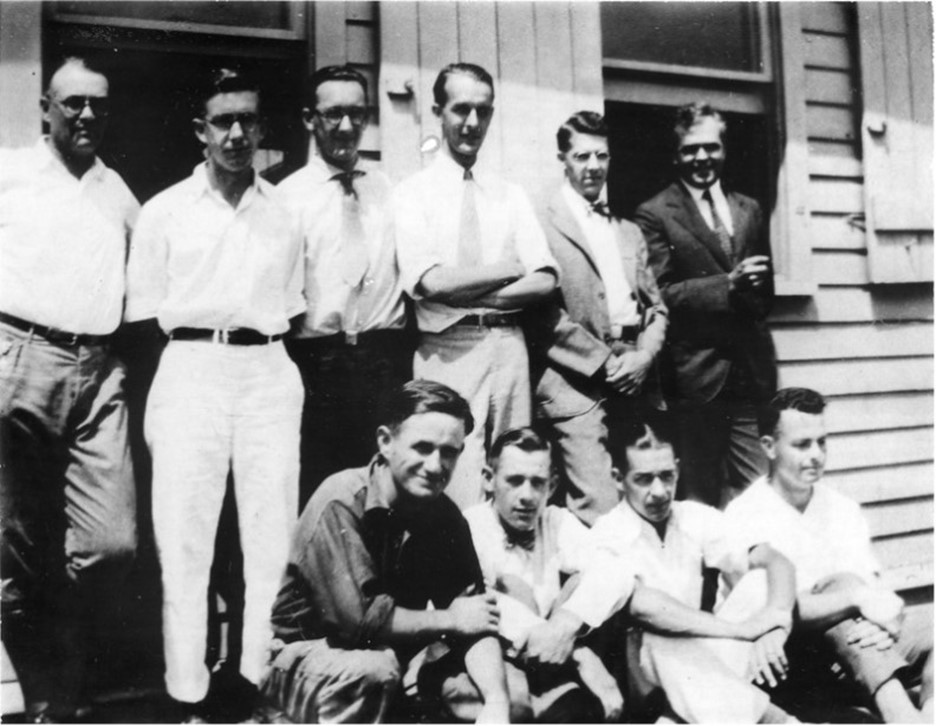
Above: Cliffwood Station, c 1928-29. Standing, from left: Carl R Englund, Lewis R Lowry, A C Beck, Warren Mutch, Karl B Feldman, and Harald T Friis. Seated, from left: M Collins, S E Reed, Art B Crawford, and E Bruce.
THE MOVE TO HOLMDEL
“The Bell Telephone Company has bought the Roberts farm on Longstreet Road and the adjoining two Herbert farms in Holmdel, where they will erect a receiving station from which to conduct radio research activities.” (Source: Daily Register, 20 Nov 1929)
When the Cliffwood property became too small to conduct efficient research work, Bell Telephone acquired 347 acres of farmland near Holmdel and the Cliffwood laboratories were shifted there in 1930. “Altho the company still owns the Cliffwood site, no work of any kind is done there now and the buildings are vacant.” (Source: Matawan Journal, 2 Aug 1935)
FIRE DESTROYS CLIFFWOOD STATION
Fire fighters from Cliffwood, Freneau, and Laurence Harbor fought a heavy brush and wood fire on the afternoon of 30 Apr 1940. The fire threatened the Bell Telephone Laboratories facility near the Morrisey-Walker development in Cliffwood. Officials reported no material damage in the blaze. (Source: Daily Record, 30 Apr 1940)
“Brush fires kept the Cliffwood firemen busy for the past week. Monday about 1 pm an alarm brought out the firemen to extinguish a grass fire near County Rd, Cliffwood. Flames spread so rapidly due to the lack of water, a small building belonging to Bell Telephone Laboratories was destroyed. Cliffwood Volunteer Co, Laurence Harbor and Oak Shades Fire Cos responded. . . . Later in the day fire broke out again in the vicinity of the County Rd and damaged several of the houses in the ‘Little Farms Section’ before being brought under control.” (Source: Matawan Journal, 2 May 1940)
MORRISEY AND WALKER DEVELOPMENT
As of Mar 1926, Morrisey and Walker was the largest seashore real estate developer in New Jersey, with 3,095 acres developed or under development in Cliffwood Beach, Laurence Harbor, Keansburg, Shark River Hills, Asbury Park, West End, and Belmar. (Source: Matawan Journal, 26 Mar 1926)
FORGOTTEN LEGACY
When a group of scientists gathered at Bell Laboratories in Holmdel to dedicate a sculpture of Karl Jansky’s antenna, no one knew just where his so-called “Merry-Go-Round” had been situated. According to a prominent scientist in attendance, “It didn’t seem right to just go out there and pick a spot. Because Jansky’s antenna was the start of our science, we wanted to mark it appropriately.” (Source: New York Times, 9 Jun 1998)
(Opening photo of Jansky antenna: Image courtesy of NRAO/AUI)

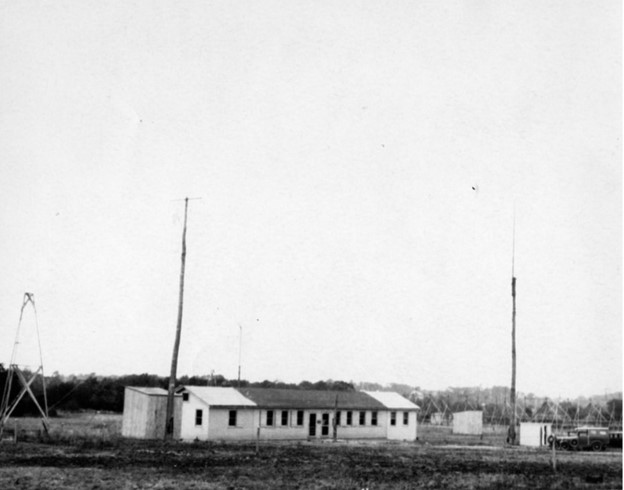
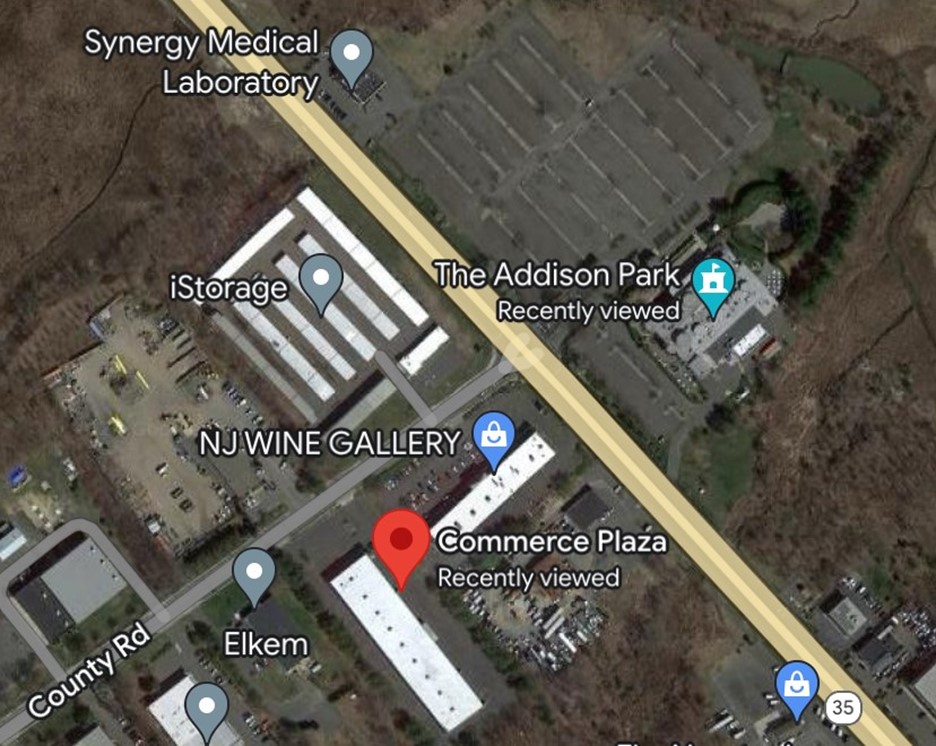
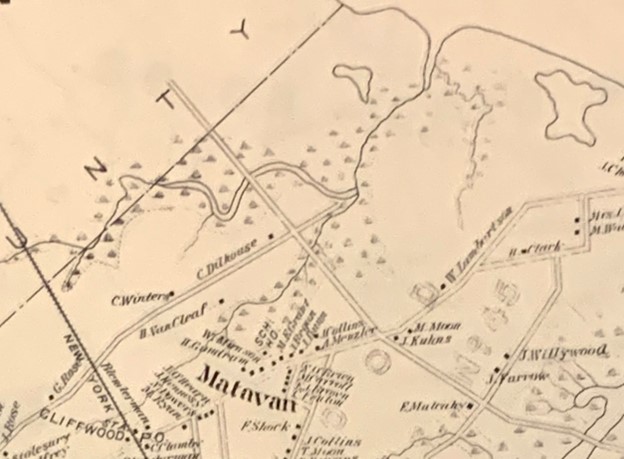

NO COMMENTS